Xerox DocuPrint 2065, DocuPrint 3055 User Guide
DocuPrint 3055/2065
User Guide
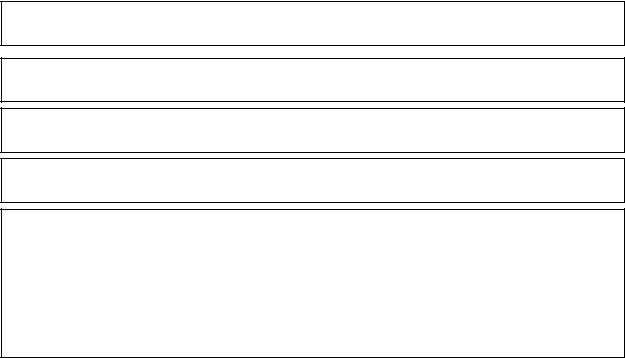
Adobe, the Adobe logo, Acrobat, Acrobat Reader, PostScript, Adobe PostScript 3, and the PostScript logo are either registered trademarks or trademarks of Adobe Systems Incorporated in the United States and/or other countries.
Microsoft, Windows, Windows NT, and Windows Server are either registered trademarks or trademarks of Microsoft Corporation in the United States and/or other countries.
Permission has been obtained from Microsoft Corporation for use of software screen shots. NetWare is a registered trademark of Novell, Inc.
Macintosh, Mac OS, AppleTalk, EtherTalk, and TrueType are trademarks of Apple Computer, Inc., registered in the U.S. and other countries.
Solaris, SunOS, and NIS (Network Information Services) are either registered trademarks or trademarks of Sun Microsystems, Inc.
RSA is registered trademarks of RSA Security Inc. BSAFE is registered trademarks of RSA Security Inc. in the United States and/or other countries.
All product/brand names are trademarks or registered trademarks of the respective holders.
For license information, refer to "About License" (P. 18).
In this manual, safety instructions are preceded by the symbol  . Always read and follow the instructions before performing the required procedures.
. Always read and follow the instructions before performing the required procedures.
It may be a legal offence to print currency notes, certificates of stocks and securities, or any other documents of similar nature, regardless of whether they will be used.
The data saved in the hard disk of the machine may be lost if there is any problem in the hard disk. Fuji Xerox is not responsible for any direct and indirect damages arising from or caused by such data loss.
Fuji Xerox is not responsible for any breakdown of machines due to infection of computer virus or computer hacking.
Important
1.This manual is copyrighted with all rights reserved. Under the copyright laws, this manual may not be copied or modified in whole or part, without the written consent of the publisher.
2.Parts of this manual are subject to change without prior notice.
3.We welcome any comments on ambiguities, errors, omissions, or missing pages.
4.Never attempt any procedure on the machine that is not specifically described in this manual. Unauthorized operation can cause faults or accidents. Fuji Xerox is not liable for any problems resulting from unauthorized operation of the equipment.
XEROX, The Document Company, and the stylized X are registered trademarks of Xerox Corporation. All Xerox and Fuji Xerox product names are either registered trademarks or trademarks of Xerox Corporation or Fuji Xerox Co., Ltd.
Preface
Thank you for purchasing the DocuPrint 3055/2065.
This guide explains how to operate this printer and the precautions that must be followed during operation.
To get the most out of this printer and to use it effectively, be sure to read this guide before use.
This guide assumes you are familiar with computers and the basics of network operation and configuration.
After reading this guide, keep it safe and handy for future reference.
Preface 3
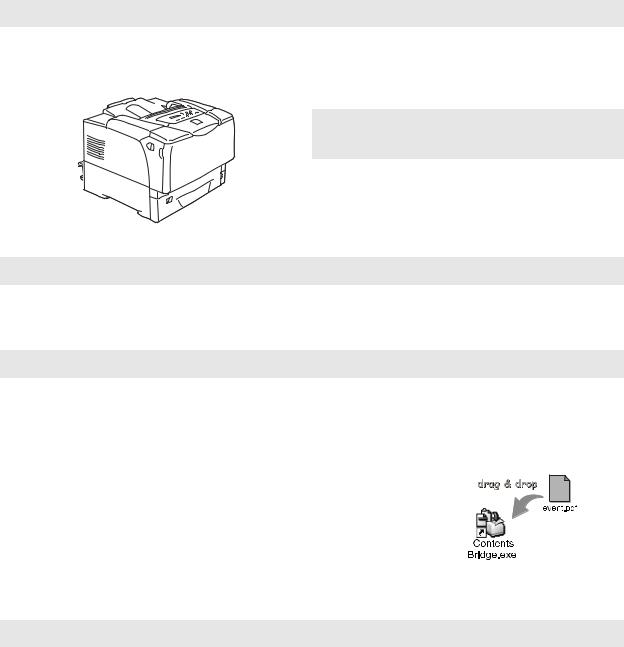
DocuPrint 3055/2065 Features
High Speed, High Image Quality
• Print speed DocuPrint 3055 : 35 ppm (A4) DocuPrint 2065 : 26 ppm (A4)
(when a single document is printed continuously one-sided)
Easy Installation and Set Up
•The oil-free fusing technology produces prints you can easily write and place sticky-notes on.
•Prints all types of documents in the optimal print quality.
Handles a Variety of Paper Sizes
and Types
•Accepts non-standard size paper, transparencies, and other special media in the paper trays as well as in the bypass tray.
•Accepts more variety of media and sizes in the bypass tray and the paper trays.
•Easy installation of a print driver using an installation tool (included in the supplied CD-ROM).
•Monitoring and remote configuration of the printer using a web browser (CentreWare Internet Services).
Wide Range of Print Features
• Multiple-Up
Prints multiple pages onto one sheet of paper.
•2 Sided Print*1
•Booklet Creation*1
•Poster
Used when creating posters.
• Watermarks
Adds a watermark such as “Confidential” underneath an original image.
• Favorites
Allows you to program frequently-used print settings.
• Sample Print*2
Allows you to print a proof copy and print the entire sets after verifying the print result.
• PDF Bridge Feature
ContentsBridge Utility enables fast and direct printing of PDF files by simply dragging and dropping files onto its icon.
Security Features
•Communication Encryption*3
Prevents information leakage caused by unauthorized access.
• Control Panel Lock
Controls access to the control panel by password entry.
• Print User Control
• Data Reception Control
Controls access to the printer by IP address (when a LPD or Port9100 port is used).
• Secure Print*2
Stores a password-protected document in the printer until you enter its password on the control panel. This feature is ideal for printing confidential documents.
Controls access to the printer by the Authentication feature.
*1: The duplex unit (optional) must be installed.
*2: The internal hard disk (optional) must be installed. *3: The network expansion card (optional) must be
installed.
The data encryption feature is not supported on the model available in China.
4 DocuPrint 3055/2065 Features
Contents
Preface.............................................................................................................. |
|
3 |
|
DocuPrint 3055/2065 Features ......................................................................... |
4 |
||
Contents............................................................................................................ |
|
5 |
|
Types of Manuals.............................................................................................. |
8 |
||
Using This Guide .............................................................................................. |
9 |
||
Safety Notes ................................................................................................... |
11 |
||
About License ................................................................................................. |
18 |
||
Illegal Copies and Printouts ............................................................................ |
19 |
||
1 |
Printer Environment Settings.................................................................... |
20 |
|
|
1.1 |
Supported Operating Environments ...................................................................... |
20 |
|
1.2 |
Connecting a Cable ............................................................................................... |
23 |
|
1.3 |
Setting the Network Environment .......................................................................... |
25 |
|
|
Setting the IP Address ........................................................................................... |
25 |
|
1.4 |
Enabling Ports ....................................................................................................... |
28 |
|
1.5 |
Configuring the Printer Using CentreWare Internet Services ................................ |
29 |
|
|
Overview of CentreWare Internet Services ........................................................... |
29 |
|
|
Using CentreWare Internet Services ..................................................................... |
32 |
|
|
Using the Online Help ............................................................................................ |
32 |
|
1.6 |
Installing a Print Driver .......................................................................................... |
33 |
|
|
Uninstalling a Print Driver and Other Software ...................................................... |
33 |
2 |
Basic Operation........................................................................................ |
34 |
|
|
2.1 |
Main Components and Functions.......................................................................... |
34 |
|
|
Main Unit ............................................................................................................... |
34 |
|
|
Control Panel ......................................................................................................... |
37 |
|
|
Control Panel Display ............................................................................................ |
38 |
|
2.2 |
Switching On/Off the Power .................................................................................. |
39 |
|
|
Switching On the Power ........................................................................................ |
39 |
|
|
Switching Off the Power ........................................................................................ |
39 |
|
2.3 |
About the Circuit Breaker ...................................................................................... |
40 |
|
2.4 |
Setting/Exiting the Power Saver Modes ................................................................ |
41 |
|
2.5 |
Cancelling/Checking a Print Job............................................................................ |
42 |
|
|
Cancelling a Print Job ............................................................................................ |
42 |
|
|
Checking the Status of a Print Job ........................................................................ |
42 |
|
2.6 |
Importing Printer Information to a Print Driver ....................................................... |
43 |
3 |
Print .......................................................................................................... |
|
44 |
|
3.1 |
Printing from a Computer ...................................................................................... |
44 |
|
3.2 |
Printing on Envelopes............................................................................................ |
46 |
|
|
Loading Envelopes ................................................................................................ |
46 |
|
|
Printing on Envelopes ............................................................................................ |
48 |
|
3.3 |
Printing on Transparencies.................................................................................... |
50 |
|
|
Loading Transparencies ........................................................................................ |
50 |
|
|
Printing on Transparencies .................................................................................... |
51 |
|
3.4 |
Printing on Non-standard Size Paper .................................................................... |
53 |
|
|
Loading Non-standard Size Paper ........................................................................ |
53 |
|
|
Registering Non-standard Size Paper ................................................................... |
53 |
|
|
Printing on Non-standard Size Paper .................................................................... |
55 |
|
3.5 |
Printing by Changing the Paper Types of the Trays.............................................. |
57 |
Contents 5
|
3.6 |
Printing Confidential Documents - Secure Print - .................................................. |
61 |
|
|
Secure Print Feature ............................................................................................. |
61 |
|
|
Printing Using the Secure Print Feature ................................................................ |
61 |
|
3.7 |
Printing After Checking the Print Result - Sample Print - ...................................... |
65 |
|
|
Sample Print Feature ............................................................................................. |
65 |
|
|
Printing Using the Sample Print Feature ............................................................... |
65 |
|
3.8 |
Printing PDF Files Directly..................................................................................... |
69 |
|
|
Printing PDF Files without Using ContentsBridge Utility ....................................... |
70 |
|
3.9 |
Printing Using E-mail - E-mail Print - ..................................................................... |
72 |
|
|
Setting the E-mail Print Feature ............................................................................ |
72 |
|
|
Sending E-mails .................................................................................................... |
74 |
|
|
Precautions When Using the E-mail Print Feature ................................................ |
77 |
4 |
Paper........................................................................................................ |
78 |
|
|
4.1 |
About Paper........................................................................................................... |
78 |
|
|
Supported Paper ................................................................................................... |
78 |
|
|
Unsupported Paper ............................................................................................... |
81 |
|
|
Storing and Handling Paper .................................................................................. |
82 |
|
4.2 |
Loading Paper ....................................................................................................... |
83 |
|
|
Loading Paper in the Bypass Tray ........................................................................ |
83 |
|
|
Loading Paper in the Trays 1 - 4 ........................................................................... |
85 |
|
|
Paper Sizes/ Paper Types of the Trays ................................................................. |
88 |
|
|
Extending the Extension Output Tray .................................................................... |
88 |
|
|
Changing the Paper Types of the Trays ................................................................ |
89 |
|
|
Setting the Paper Sizes of the Trays ..................................................................... |
90 |
|
|
Auto Tray Selection Feature .................................................................................. |
92 |
5 |
Control Panel Menus................................................................................ |
93 |
|
|
5.1 |
Overview of the Common Menus .......................................................................... |
93 |
|
|
Menu Structure ...................................................................................................... |
93 |
|
|
Changing the Settings ........................................................................................... |
95 |
|
5.2 |
Setting the Common Menus .................................................................................. |
98 |
|
|
[Print Language] .................................................................................................... |
98 |
|
|
[Report/List] ......................................................................................................... |
102 |
|
|
[Meter Reading] ................................................................................................... |
102 |
|
|
[Admin Menu] ...................................................................................................... |
102 |
6 |
Troubleshooting...................................................................................... |
133 |
|
|
6.1 |
Clearing Paper Jams ........................................................................................... |
133 |
|
|
Paper Jams in the Bypass Tray ........................................................................... |
135 |
|
|
Paper Jams in the Trays 1 - 4 ............................................................................. |
136 |
|
|
Paper Jams in the Fuser Unit .............................................................................. |
138 |
|
|
Paper Jams in the Duplex Unit ............................................................................ |
139 |
|
|
Paper Jams in the Output Area ........................................................................... |
140 |
|
6.2 |
Hardware Problems (Power Failure, Abnormal Noise, etc.)................................ |
141 |
|
6.3 |
Printing Problems ................................................................................................ |
142 |
|
6.4 |
Print Quality Problems......................................................................................... |
144 |
|
6.5 |
Paper Feeding Problems..................................................................................... |
148 |
|
6.6 |
Error Messages and Error Codes........................................................................ |
149 |
|
|
Error Messages (in Alphabetical Order) .............................................................. |
149 |
|
|
Error Codes ......................................................................................................... |
153 |
|
6.7 |
Network-related Problems ................................................................................... |
155 |
|
|
CentreWare Internet Services Problems ............................................................. |
155 |
|
|
E-Mail Print/StatusMessenger Problems ............................................................. |
157 |
6 Contents
7 Maintenance........................................................................................... |
158 |
|
7.1 |
Replacing Consumable ....................................................................................... |
158 |
|
Type of Consumable ........................................................................................... |
158 |
|
Replacing the Print Cartridge .............................................................................. |
160 |
7.2 |
Printing the Reports/Lists .................................................................................... |
164 |
|
Types of the Reports/Lists ................................................................................... |
164 |
|
Printing a Report/List ........................................................................................... |
166 |
7.3 |
Monitoring/Managing the Printer on a Web Browser........................................... |
167 |
7.4 |
Checking the Printer Status via SimpleMonitor ................................................... |
168 |
7.5 |
Checking the Printer Status via E-mail ................................................................ |
169 |
|
Setting the StatusMessenger Feature ................................................................. |
170 |
|
Checking the Printer Status via E-mail ................................................................ |
171 |
7.6 |
Security Features ................................................................................................ |
172 |
|
SSL Data Encryption for HTTP Communication .................................................. |
172 |
|
Controlling Data Reception by IP Address .......................................................... |
177 |
7.7 |
Checking the Meter Reading ............................................................................... |
179 |
|
Checking the Meter Reading (Meter) .................................................................. |
179 |
|
Checking the Meter Reading by Computer (Meter Report) ................................. |
180 |
7.8 |
Authentication and Auditron Administration Features ......................................... |
181 |
|
Overview of the Authentication and Auditron Administration Features ............... |
181 |
|
Configuring the Authentication and Auditron Administration Features ................ |
182 |
|
Registering Login Information on the Printer ....................................................... |
183 |
7.9 |
Cleaning the Printer............................................................................................. |
187 |
|
Cleaning the Exterior ........................................................................................... |
187 |
|
Cleaning the Rib Plate ......................................................................................... |
188 |
|
Cleaning the Feed Rolls ...................................................................................... |
190 |
7.10 |
Moving the Printer ............................................................................................... |
198 |
A Appendix ................................................................................................ |
200 |
|
A.1 |
Main Specifications.............................................................................................. |
200 |
|
Product Specifications ......................................................................................... |
200 |
|
Printable Area ...................................................................................................... |
204 |
A.2 |
Optional Accessories........................................................................................... |
205 |
A.3 |
Life of Consumable and Regular Replacement Part ........................................... |
206 |
A.4 |
Obtaining the Product Information....................................................................... |
207 |
|
Obtaining the Latest Print Driver ......................................................................... |
207 |
|
Updating the Printer's Firmware .......................................................................... |
207 |
A.5 |
Installing Additional Memory................................................................................ |
208 |
|
Installation Procedure .......................................................................................... |
209 |
A.6 |
Installing the Internal Hard Disk........................................................................... |
212 |
|
Checking the Package Contents ......................................................................... |
212 |
|
Installation Procedure .......................................................................................... |
213 |
A.7 |
Installing the Chinese Font Kit............................................................................. |
216 |
|
Checking the Package Contents ......................................................................... |
216 |
|
Installation Procedure .......................................................................................... |
217 |
A.8 |
Installing the KR Font Kit ..................................................................................... |
220 |
|
Checking the Package Contents ......................................................................... |
220 |
|
Installation Procedure .......................................................................................... |
221 |
A.9 |
Notes and Restrictions ........................................................................................ |
224 |
|
Notes and Restrictions on Using the Printer ........................................................ |
224 |
A.10 |
Glossary .............................................................................................................. |
225 |
Index ............................................................................................................. |
|
230 |
Control Panel Menu Tree.............................................................................. |
233 |
|
Contents 7
Types of Manuals
Setup Guide |
Provides step-by-step instructions on how to set up your printer. |
|
|
Quick Reference Guide |
Provides information such as how to get ready to print, basic operating |
|
instructions, and troubleshooting tips. It also describes how to install |
|
additional memory (optional), the internal hard disk (optional), the |
|
Chinese font kit (optional), and the KR font kit (optional) to the printer. |
|
Refer to the ‘User Guide’ for more details and information not covered |
|
in this guide. |
|
|
User Guide (PDF) |
Describes how to get ready to print and set various print features. It |
(this guide) |
also covers the control panel menus, troubleshooting tips, and |
|
maintenance information. |
|
• This guide is on the CD-ROM of the Driver CD Kit under [Model- |
|
specific Manual (PDF Document)]. |
|
|
CD-ROM Documentation |
Describes how to set up the printer’s operating environment and to |
(HTML) |
install a print driver and various Fuji Xerox software. |
|
• This guide is on the CD-ROM of the Driver CD Kit. |
|
|
Emulation Setting Guide (PDF) |
Contains information about the ESC/P and PCL emulation modes. |
|
• This guide is on the CD-ROM of the Driver CD Kit under [Model- |
|
specific Manual (PDF Document)]. |
|
|
PostScript User Guide (PDF) |
Describes how to set up your printer as a PostScript printer and the |
|
features that can be configured on your print driver. |
|
• This guide is on the PostScript Driver Library CD-ROM included in |
|
the PostScript software kit (optional). |
|
|
Installation guides for the |
Most optional accessories (sold separately) come with installation |
optional accessories |
guides. |
|
|
Note
•To view PDF files, you must have Adobe® Acrobat® Reader® or Adobe® Reader® installed on your computer. If you do not have it installed, install it from the CD-ROM of the Driver CD Kit.
8 Types of Manuals

Using This Guide
Organization
This guide is organized into the following chapters. The summary of each chapter is as follows:
1 |
Printer Environment Setting |
Describes how to set up the printer’s operating environment. |
|
|
|
2 |
Basic Operation |
Provides the names and functions of the printer's components and the |
|
|
basic operating procedures (such as switching the power on/off and |
|
|
cancelling print jobs). |
|
|
|
3 |
Describes various printing methods using the PCL print driver. |
|
|
|
|
4 |
Paper |
Describes the supported paper types and how to load paper in the |
|
|
printer. |
|
|
|
5 |
Control Panel Menus |
Describes the control panel menus and how to configure them. |
|
|
|
6 |
Troubleshooting |
Contains problem solving procedures that help quickly resolve |
|
|
problems (such as paper jams and errors). |
|
|
|
7 |
Maintenance |
Provides maintenance information, such as replacing consumable and |
|
|
printing various reports/lists. |
|
|
It also contains information intended for the administrators, such as |
|
|
CentreWare Internet Services (a tool that enables monitoring and |
|
|
remote configuration of the printer), various security features, and the |
|
|
Authentication and Auditron Administration features. |
|
|
|
A Appendix |
Describes the printer specifications, optional accessories, life of |
|
|
|
consumable, and how to obtain the product information. |
|
|
|
Using This Guide |
9 |
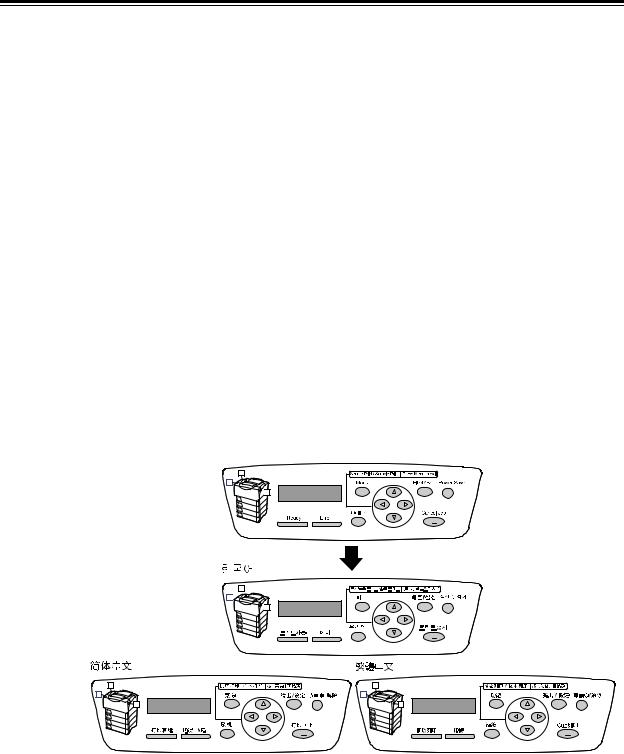
Conventions
1.In this guide, personal computers and workstations are collectively called "computers".
2.The following terms are used throughout this guide:
Important |
|
: Important information that must be read and followed. |
Note |
|
: Additional information that merits emphasis. |
Refer to " |
" |
: References within this guide. |
Refer to ‘ |
‘ |
: References to other publications. |
3.The following symbols are used throughout this guide:
[ |
] |
: The names of the menu items on your computer or the printer’s |
|
|
control panel display, or the names of the reports/lists that can be |
|
|
printed from the printer. |
< |
> |
: The names of the keys on your computer keyboard or the hardware |
|
|
buttons or lamps on the printer's control panel. |
> |
|
: The hierarchies of the menus on the control panel display, print |
|
|
driver, or CentreWare Internet Services. |
4.The illustrations used in this guide are those of the DocuPrint 3055. If your printer is the DocuPrint 2065, only the illustration of the standard paper tray differs from that used in this guide.
5.In this guide, the control panel buttons/lamps are presented in English. If you placed the control panel labels (included with the printer) on your control panel, use the following figure to identify the names of the buttons/lamps in your language.
C
B
 A
A
1
2
3
4
C
B
 A
A
1
2
3
4
C |
C |
B |
B |
A |
A |
1 |
1 |
2 |
2 |
3 |
3 |
4 |
4 |
10 Using This Guide
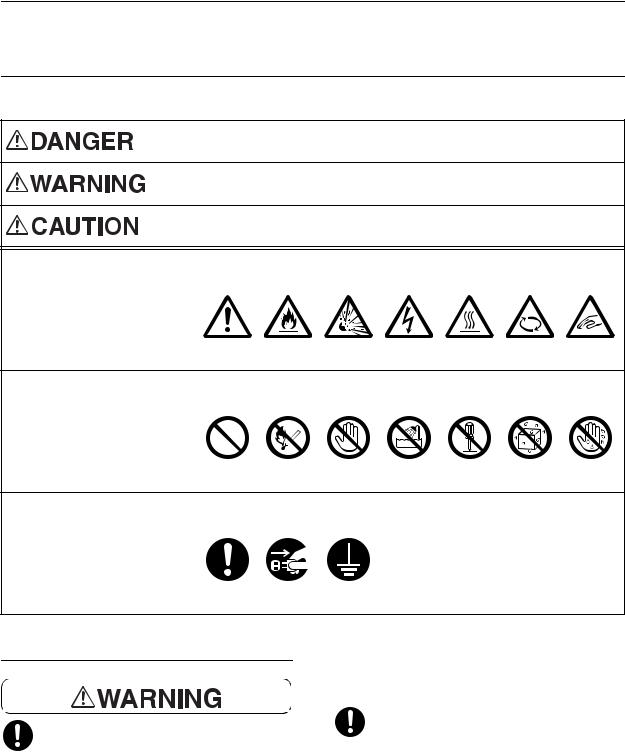
Safety Notes
Read these safety notes carefully before using this product to make sure you operate the equipment safely.
Your Fuji Xerox product and recommended supplies have been designed and tested to meet strict safety requirements. These include safety agency approval, and compliance to established environmental standards. Please read the following instructions carefully.
 WARNING
WARNING
•Any unauthorized alteration, which may include the addition of new functions or connection of external devices, may impact the product certification. Please contact your authorized Service Provider for more information.
All warning instructions marked on or supplied with the product should be followed.
Used for item that if not followed strictly, can lead death or severe or fatal injuries and the possibility to do it is comparatively high.
Used for items that if not followed strictly, can lead to severe or fatal injuries.
Used for items that if not followed strictly, can cause injuries to user or damages to machine.
 A symbol for items to pay attention to when handling machine.
A symbol for items to pay attention to when handling machine.
Follow instructions carefully to use machine safely.
Caution Flammable Explodable Electric |
Heated |
Moving |
Pinched |
shock |
surface |
object |
fingers |
 A symbol for prohibited items. Follow instructions carefully to avoid any dangerous acts.
A symbol for prohibited items. Follow instructions carefully to avoid any dangerous acts.
Prohibited |
No fire |
Do not |
Do not use |
Do not |
Keep away |
Never touch |
|
|
touch |
in bathroom |
tear down |
from wet |
with wet hand |
 A symbol for items that must be performed. Follow instructions carefully to carry out these essential tasks.
A symbol for items that must be performed. Follow instructions carefully to carry out these essential tasks.
Instructions Unplug |
Ground/ |
|
Earth |
Electrical Safety
Plug the power cord directly into a grounded electrical outlet easily accessible. Do not use an extension cord, a multi-plug adaptor or a multiple connector. It may cause the outlet to overheat and cause fire. Ensure to operate
the machine on a sole-use receptacle. If you do not know whether an outlet is grounded, consult a qualified electrician.
This equipment is to be used on a branch circuit or outlet that has larger capacity than rated ampere and voltage of this machine. See data plate on the rear panel for the rated ampere and voltage of this equipment.
Safety Notes |
11 |
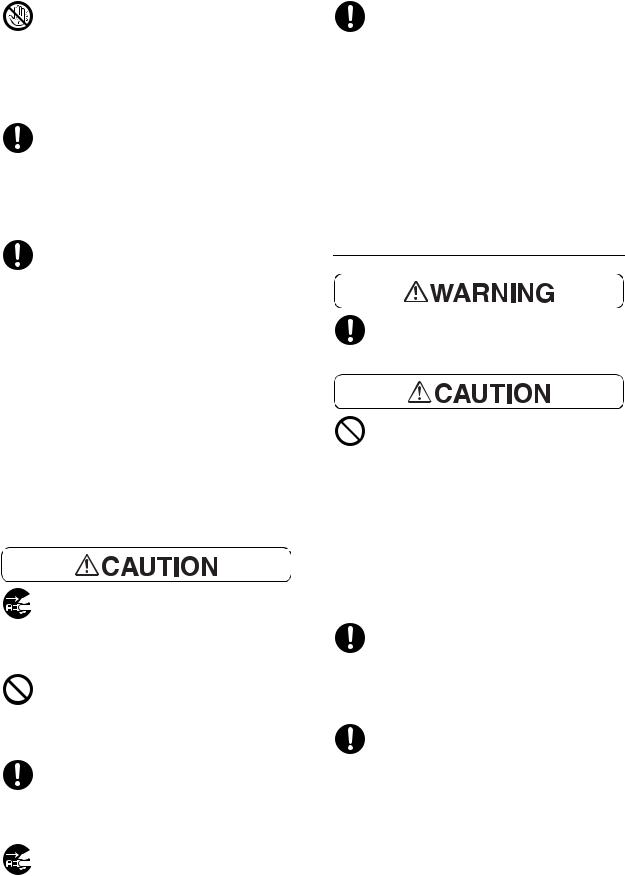
Never touch a power cord with wet hands. Danger of electric shock exist. It can cause electric shocks.
 Do not place objects on the power cord.
Do not place objects on the power cord.
Always ensure the plug connection is free of dust. In a damp environment, a contaminated connector can draw a significant amount of current that can generate heat and eventually cause fire over an extended period of time.
Only use the power cord supplied with the equipment.
Do not use it on any other power source, doing so can cause fire, electric shocks or machine faults. Using a different power cord may cause fire or electric shock. Do not use power cord supplied with the equipment on any other equipment.
Do not attempt to rework, pull, bend, chafe, or otherwise damage the power cord. A damaged cord can cause fire or electric shocks.
If the power cord is broken or insulated wires are exposed, ask your local Fuji Xerox representative for a replacement. Using a damaged cord can cause fire or electric shocks.
Before cleaning this product, ensure to switch off and unplug the product from the electrical outlet. Access to a live machine interior can cause electric shocks.
Do not unplug or replug the machine while it is switched on. Unplugging a live connector can deform the plug and cause fire.
When unplugging the machine, grasp the plug instead of the cord. Pulling on a cord can damage the cord and cause fire or electric shocks.
Always switch off and unplug the machine when it is not used over weekends or long holidays.
Once a month, unplug the machine and check the power cord for the following:
•The power cord is plugged firmly into a receptacle.
•The plug is not excessively heated, rusted, or bent.
•The plug and receptacle are free of dust.
•The cord is not cracked or frayed.
If you notice any unusual conditions, contact your local Fuji Xerox representative.
Machine Installation
Do not place this equipment where people might step on or trip over the power cord.
Never locate the equipment;
-Near radiator or any other heat source
-Near volatile, flammable or combustible materials such as curtains
-In a hot, humid, dusty or poorly ventilated environment
-In a place receiving direct sunlight
-Close to a cooker or humidifier that emits oily fumes or steam
The machine (only the main unit including a consumable) weighs 23.5 kg/20.8 kg (DocuPrint 3055/DocuPrint 2065). Make sure to carry the equipment by two or more persons.
When lifting the machine, firmly grip the recessed areas provided on both sides of the machine. Never try to lift the machine by gripping any other areas. Lifting the machine by gripping any other areas can cause the machine to fall and result in injuries.
12 Safety Notes
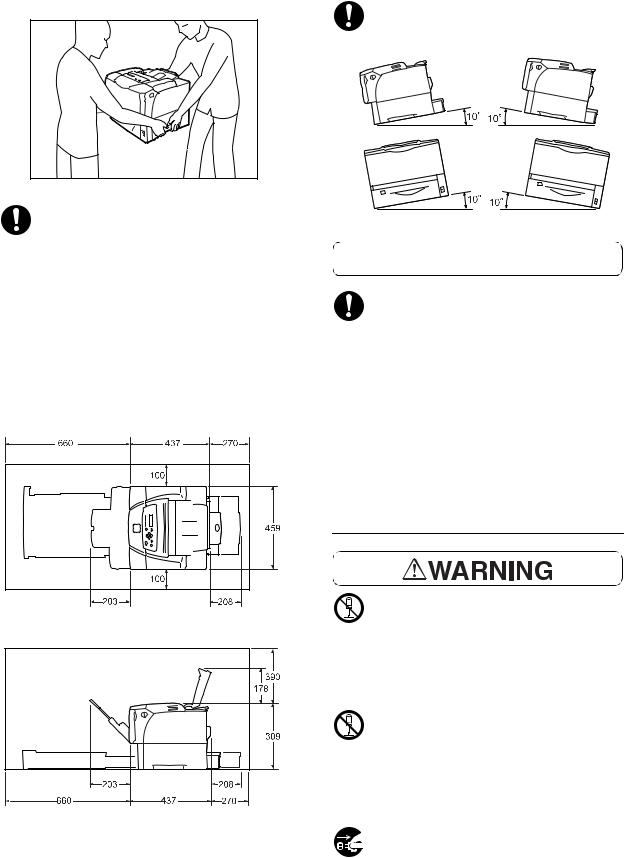
Do not obstruct the ventilation openings. The machine has ventilation opening. Poor ventilation may cause overheat inside the machine and can lead a fire.
Always locate the equipment in an area that has adequate ventilation, and space for servicing. See installation instructions for minimum dimensions. Keep the ventilation and service space clear to allow an access to the power plug. You would be required to unplug the machine when an abnormal condition is encountered.
Unit:mm |
Do not incline the product more than 10 degrees.
Others
In order to use and maintain this product in a good performance and condition, make sure to use the product within the following environment:
•Temperature: 10~32°C
•Humidity: 35~85%
When the product is left in a freezing cold room and the room is rapidly warmed up by heater, it can generate water drops inside the machine and cause a partial deletion on printing.
Operational Safety
Any operator product maintenance procedures will be described in the customer documentation supplied with the product. Do not carry out any maintenance procedures on this product which are not described in the customer documentation.
This equipment has been designed to restrict operator access to safe areas only. Operator access to hazardous areas is restricted with covers or guards, which would require a tool to remove. Never remove these covers or guards.
If any of the following conditions occur, switch off the power to the machine immediately and disconnect the power cord from the electrical outlet. Call an authorized local service representative to correct the problem.
Safety Notes |
13 |
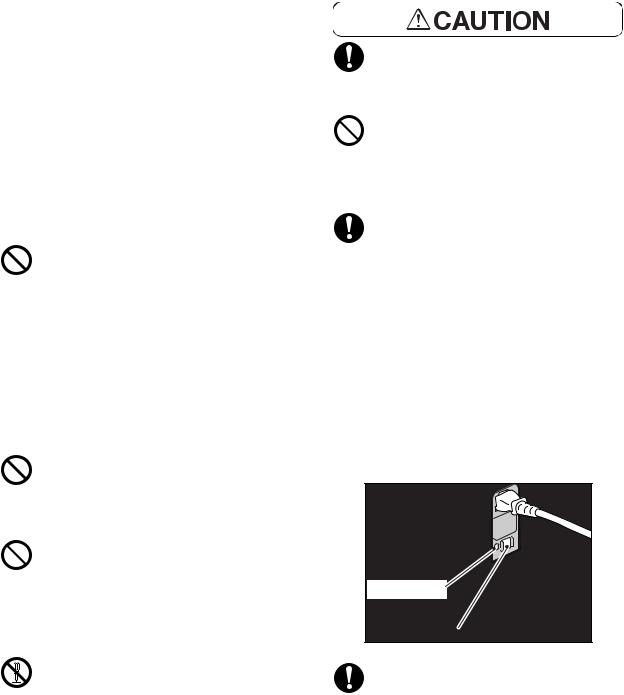
-The equipment emits smoke or a surface of the equipment becomes unusually hot.
-The equipment emits unusual noises or odors.
-The power cord is damaged or frayed.
-A wall panel circuit breaker, fuse, or other safety device has been tripped.
-Liquid has spilled into the equipment.
-The equipment is exposed to water.
-Any part of the equipment is damaged.
Never push objects of any kind into slots or openings on the equipment. Do not place any of the followings on the machine;
-Liquid container such as a vase or coffee cup
-Metal parts such as staples or clips
-Heavy object
When those are spilled over, slipped into or fall from the machine, it can cause electric shock, fire or injury.
Do not use conductive paper, e.g. carbonic paper or coated paper. When paper jam occurs, they can cause a short-circuit and fire.
Always use materials specified for this product. The use of other materials may result in poor performance and may create a hazardous situation. Do not use aerosol cleaners, they may be explosive and flammable under certain circumstances.
Laser Safety
CAUTION: Use of controls, adjustments or performance of procedures other than those specified herein may result in hazardous light exposure.
With specific regard to laser safety, the equipment complies with performance standards for laser products set by government, national and international agencies as a Class 1 laser product. It does not emit hazardous light, as the beam is totally enclosed during all phases of customer operation and maintenance.
Always follow all warnings and instructions that are marked on or supplied with the equipment.
Do not override or disable electrical or mechanical interlocks. Do not place a magnet near the safety switch of the machine. A magnet can activate the machine accidentally, resulting in injuries.
The machine has a circuit breaker. In the event of a current leakage, the breaker will automatically cut off the power circuit to prevent any leakages or fire.
The breaker is normally On ("|"). Once a month, check the breaker for
correct operation by using the following procedure.
1.Press the Test button. The breaker switch is turned Off. ("O") (This means that the breaker is OK.)
2.Return the breaker switch to On ("|").
If you notice any unusual condition, contact your local Fuji Xerox representative.
TEST button |
RESET button |
When removing jammed paper, do not try to remove paper or paper piece deep inside the machine. Also, do not try to remove paper wrapped around the heat roller. It can cause injury or burn.
Switch off the machine immediately and contact your local Fuji Xerox representative.
14 Safety Notes
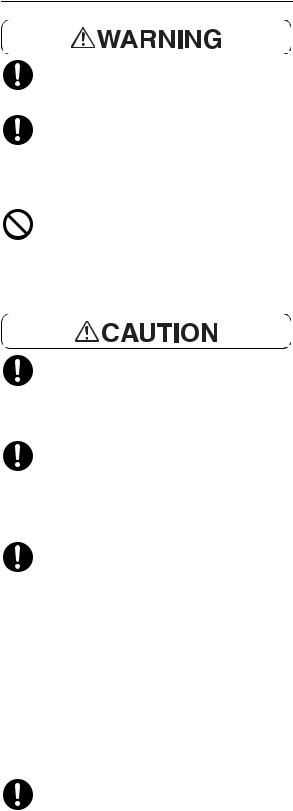
Consumable
Store all consumables in accordance with the instructions given on the package or container.
Do not use a vacuum cleaner for cleaning the spilled toner. Use a broom or a soaked cloth to clean any spills. Vacuumed toner inside the cleaner can ignite or explode by an electric spark of the cleaner and may cause an injury.
Never throw a print cartridge into fire. Remaining toner in the cartridge may catch fire and cause burn injuries. If you have a used print cartridge no longer needed, contact your local Fuji Xerox representative for its disposal.
Keep the print cartridge out of reach of children. Should toner be swallowed, spit it out, rinse mouth with water and drink plenty of water. Consult a physician immediately.
When replacing the print cartridge, be careful not to spill the toner. In case of any toner spills, avoid contact with skin and clothing, as well as inhalation and contact with eyes and mouth.
In case of any toner spills onto your skin and clothing, wash with soap and water.
Should toner particles get into your eyes, flush with plenty of water for at least 15 minutes until the irritation is gone. If necessary, seek medical treatment from a doctor.
If toner particles are inhaled, move to a location with fresh air and gargle with plenty of water.
Should toner be swallowed, spit it out, rinse mouth with water and drink plenty of water. Consult a physician immediately.
Fuser Safety:
When removing the fuser unit, make sure you switch off the power first and wait for 40 minutes before removing it.
Safety Notes |
15 |
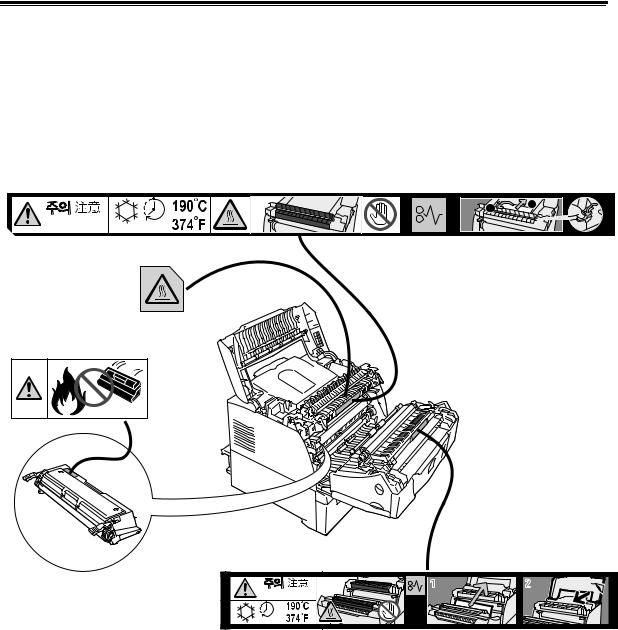
Warning and Caution Labels
Be sure to follow the warning and caution labels placed on the machine. Do not touch areas with labels indicating high voltage or temperature. This can cause an electric shock or burn.
|
2 |
CAUTION |
00:40 |
1 |
2 |
CAUTION |
|
0 0 : 4 |
|
16 Safety Notes

Environment
•For environmental protection and efficient use of resources, returned print cartridges are reused as parts, recycled materials, or reused for energy generation.
•Proper disposal of unwanted print cartridges is required. Print cartridge containers should not be opened with force and must be returned to your local Fuji Xerox representative.
Regulation
Radio Frequency Emissions (Class B):
This equipment has been tested and found to comply with the limits for a Class B digital device, pursuant to the International Standard for Electromagnetic Interference (CISPR Publ. 22) and Radio communication Act 1992 in Australia/New Zealand. These limits are designed to provide reasonable protection against harmful interference in a residential installation. This equipment generates, uses and can radiate radio frequency energy and, if not installed and used in accordance with the instructions, may cause harmful interference to radio communications. However, there is no guarantee that interference will not occur in a particular installation. If this equipment does cause harmful interference to radio or television reception, which can be determined by turning the equipment off and on, the user is encouraged to try to correct the interference by one or more of the following measures:
•Reorient or relocate the receiving antenna.
•Increase the separation between the equipment and receiver.
•Connect the equipment into an outlet on a circuit different from that to which the receiver is connected.
•Consult the dealer or an experienced radio/TV technician for help.
Changes and modifications to this equipment not specifically approved by Fuji Xerox may void the user's authority to operate this equipment.
Safety Notes |
17 |
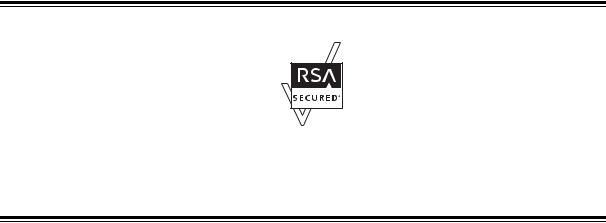
About License
RSA BSAFE (For the Models Other than those Available in China)
This product (network expansion card (optional)) includes RSA BSAFE encryption software from RSA Security Inc.
JPEG Code
Our printer software uses some of the codes defined by the Independent JPEG Group.
18 About License
Illegal Copies and Printouts
Copying or printing certain documents may be illegal in your country. Penalties of fines or imprisonment may be imposed on those found guilty. The following are examples of items that may be illegal to copy or print in your country.
•Currency
•Banknotes and checks
•Bank and government bonds and securities
•Passports and identification cards
•Copyright material or trademarks without the consent of the owner
•Postage stamps and other negotiable instruments
This list is not inclusive and no liability is assumed for either its completeness or accuracy. In case of doubt, contact your legal counsel.
Illegal Copies and Printouts |
19 |
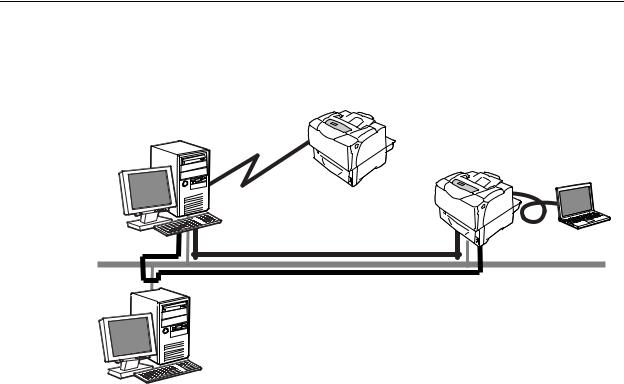
1 Printer Environment Settings
When you are finished installing your printer using the ‘Setup Guide’, go on to set up its operating environment.
1.1Supported Operating Environments
The printer can be used both as a local and a network printer. When used as a local printer, the printer is connected directly to a computer. When used as a network printer, the printer is connected to a computer over a network.
Set all ports you want to use to [Enable] on the control panel.
Internet
IPP
Local Connection
Parallel/USB
Network Connection |
LPD/SMB/Port9100/EtherTalk/FTP |
Network Connection
NetWare/Windows Shared Printer
Server
Using the Printer as a Local Printer
When using the printer as a local printer, the printer and a computer can be connected using the following methods:
• |
Parallel connection |
: Connecting the printer and a computer using a parallel cable. |
|
|
(default: [Enable]) |
• |
USB connection |
: Connecting the printer and a computer using a USB cable. |
|
|
(default: [Enable]) |
Using the Printer as a Network Printer
When using the printer as a network printer, the printer can be set up in the following environments:
• |
LPD |
: Used when using TCP/IP protocol to enable direct communication between |
|
|
the printer and a computer. (default: [Enable]) |
• |
Port9100 |
: Used when using a Port9100 port. |
|
|
(default: [Enable]) |
• |
FTP |
: Used when printing using an FTP service. |
|
|
(default: [Enable]) |
20 1 Printer Environment Settings
When the network expansion card (optional) is installed, the printer can be set up also in the following environments:
• |
NetWare |
: Used when sharing and managing the printer using a NetWare server. |
|
|
(default: [Enable]) |
• |
SMB |
: Used when printing using a Windows network. |
|
|
(default: [Enable]) |
• |
IPP |
: Used when printing via the Internet. |
|
|
(default: [Enable]) |
• |
EtherTalk |
: Used when printing from Macintosh . |
|
|
(default: [Enable]) |
1.1 Supported Operating Environments |
21 |
Supported Operating Systems and Operating Environments
Note
•The supported operating systems are subject to change without prior notice. Visit our web site for the latest information.
Connection |
|
|
Local |
|
|
|
|
|
|
|
|
|
Network |
|
|
|
|
|
|
||
Method |
|
|
|
|
|
|
|
|
|
|
|
|
|
|
|
|
|
||||
|
|
|
|
|
|
|
|
|
|
|
|
|
|
|
|
|
|
|
|
|
|
|
|
|
|
|
|
|
|
|
|
|
|
|
|
|
|
|
|
|
|
|
|
Port Name |
|
Paral |
USB |
*2 |
|
LPD |
NetWare |
*1 |
SMB |
*1 |
IPP |
*1 |
|
Port |
|
Ether |
FTP |
||||
|
lel |
|
|
|
9100 |
|
Talk*1 |
||||||||||||||
|
|
|
|
|
|
|
|
|
|
|
|
||||||||||
Protocol |
|
- |
|
- |
|
|
TCP/ |
TCP/ |
|
IPX/ |
Net |
|
TCP/ |
TCP/IP |
|
TCP/ |
|
Apple |
TCP/ |
||
|
|
|
|
IP |
IP |
|
SPX |
BEUI |
|
IP |
|
IP |
|
Talk |
IP |
||||||
|
|
|
|
|
|
|
|
|
|
|
|
|
|||||||||
|
|
|
|
|
|
|
|
|
|
|
|
|
|
|
|
|
|
|
|
|
|
|
|
|
|
|
|
|
|
|
|
|
|
|
|
|
|
|
|
|
|
|
|
Windows 95 |
|
O |
|
|
|
|
O*4 |
O |
|
|
O |
O |
|
O |
|
|
|
O*4 |
|
|
O |
Windows 98 |
|
O |
|
O*3 |
|
O*4 |
O |
|
|
O |
O |
|
O |
|
|
|
O*4 |
|
|
O |
|
Windows Me |
|
O |
|
O |
|
|
O*4 |
O |
|
|
O |
O |
|
O |
O |
|
|
O*4 |
|
|
O |
Windows NT 4.0 |
|
O |
|
|
|
|
O |
O |
|
|
O |
O |
|
O |
|
|
|
|
|
|
O |
Windows 2000 |
|
O |
|
O |
|
|
O |
O |
|
|
O |
O |
|
O |
O |
|
|
O |
|
|
O |
Windows XP |
|
O |
|
O |
|
|
O |
O |
|
|
O |
|
|
O |
O |
|
|
O |
|
|
O |
Windows Server |
|
O |
|
O |
|
|
O |
O |
|
|
O |
|
|
O |
O |
|
|
O |
|
|
O |
2003 |
|
|
|
|
|
|
|
|
|
|
|
|
|
|
|
|
|
|
|
|
|
|
|
|
|
|
|
|
|
|
|
|
|
|
|
|
|
|
|
|
|
|
|
Mac OS *5 |
|
|
|
O*6 |
|
|
|
|
|
|
|
|
|
|
|
|
|
|
O |
|
|
8.6 - 9.2 |
|
|
|
|
|
|
|
|
|
|
|
|
|
|
|
|
|
|
|
|
|
|
|
|
|
|
|
|
|
|
|
|
|
|
|
|
|
|
|
|
|
|
|
Mac OS X |
|
|
|
O |
|
|
O |
|
|
|
|
|
|
|
O*8 |
|
|
|
O |
|
|
10.2.8*5/ |
|
|
|
|
|
|
|
|
|
|
|
|
|
|
|
|
|
|
|
|
|
10.3.9/10.4*7 |
|
|
|
|
|
|
|
|
|
|
|
|
|
|
|
|
|
|
|
|
|
|
|
*1: The network expansion card (optional) must be installed. |
|
|
|
|
|
|
|
||||||||||||
|
|
*2: USB port must be set on the computer connected to the printer. On Windows 98/Me, USB |
|
||||||||||||||||||
|
|
Print Utility (software by Fuji Xerox Co., Ltd.) must be used. USB Print Utility can be |
|
|
|||||||||||||||||
|
|
installed from the CD-ROM of the Driver CD Kit included with the printer. |
|
|
|
|
|||||||||||||||
|
|
*3: Supported on Windows 98 Second Edition or later. |
|
|
|
|
|
|
|
|
|||||||||||
|
|
*4: On Windows 95/98/Me, TCP/IP Direct Print Utility (software by Fuji Xerox Co., Ltd.) must |
|
||||||||||||||||||
|
|
be used. TCP/IP Direct Print Utility will be installed automatically if you install a print driver. |
|
||||||||||||||||||
|
|
*5: To print PostScript data from Macintosh computers, the PostScript software kit (optional) |
|
||||||||||||||||||
|
|
must be installed. |
|
|
|
|
|
|
|
|
|
|
|
|
|
|
|||||
|
|
*6: Supported on Mac OS 9.2 or later. |
|
|
|
|
|
|
|
|
|
|
|
|
|||||||
|
|
*7: On Mac OS 10.3.9 or later, printing can be performed using the printer driver for |
|
|
|||||||||||||||||
|
|
Macintosh. The printer driver for Macintosh can be downloaded from our web site. For |
|
||||||||||||||||||
|
|
more information, refer to the manual on the same web site. Also, when using the printer |
|
||||||||||||||||||
|
|
driver for Macintosh, additional memory of 256 MB or above is recommended. |
|
|
|||||||||||||||||
|
|
*8: Supported on Mac OS X 10.3.9 or later. |
|
|
|
|
|
|
|
|
|
|
|||||||||
Note
•For information on how to print from Macintosh computers other than the above, contact our Customer Support Center or your dealers.
•When installing the PostScript software kit (optional) to the printer, additional memory of 256 MB or above is recommended.
22 1 Printer Environment Settings

1.2Connecting a Cable
Connect the printer to your computer using an interface cable appropriate for your connection method.
An interface cable is not included with the printer. You must purchase it separately.
Parallel Connection
1.Switch the printer off.
2.Plug the parallel cable into the interface connector on the printer.
Secure the parallel cable into the connector
using the metal pieces on both sides of the connector.
3. Plug the other end of the parallel cable into your computer.
4.Switch the printer on.
USB Connection
When using USB connection, install a print driver on your computer before connecting the cable. For installation instructions, refer to "1.6 Installing a Print Driver" (P. 33) or the ‘CDROM Documentation (HTML)’ on the CD-ROM of the Driver CD Kit.
1.Switch the printer off.
2.Plug the USB cable into the interface connector on the printer.
3. Plug the other end of the USB cable into your computer.
4. Switch the printer on.
1.2 Connecting a Cable |
23 |
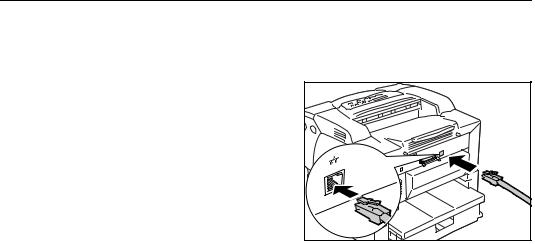
Network Connection
Use a straight-type network cable that supports 100BASE-TX or 10BASE-T.
1.Switch the printer off.
2.Plug the network cable into the interface connector on the printer.
3. Plug the other end of the network cable into a network device such as a hub.
4. Switch the printer on.
24 1 Printer Environment Settings

1.3Setting the Network Environment
This section explains how to install your printer in a TCP/IP environment.
When installing the printer in a different environment, refer to the ‘CD-ROM Documentation (HTML)’ on the CD-ROM of the Driver CD Kit.
Setting the IP Address
To use TCP/IP protocol, you must configure an IP address for the printer.
By default, the printer is set to obtain its IP address (via the [Get IP Address] setting on the control panel) using [DHCP/Autonet]. Thus, when the printer is connected to a network that has a DHCP server, the printer automatically obtains its IP address from the server.
Print the [Printer Settings] list to see if the printer already has an IP address.
If the printer does not have an IP address, set [Get IP Address] to [Panel] and configure the address.
Note
If an IP address is listed, skip the following procedure.
If an IP address is not listed, or if you want to change the current IP address, configure the setting using the following procedure.
•For information on how to print the [Printer Settings] list, refer to "7.2 Printing the Reports/Lists" (P. 164).
•The printer can obtain its IP address also by using a BOOTP or RARP server. If using a BOOTP or RARP server, set [Get IP Address] to [BOOTP] or [RARP].
•If using a DHCP server, the printer’s IP address may change without notice. Make sure to check the IP address periodically.
•To use DHCP in a WINS (Windows Internet Name Service) environment, the network expansion card (optional) must be installed.
Use the following procedure to configure the printer’s IP address on the control panel.
Depending on your network environment, your printer also needs a subnet mask and gateway address. Consult your network administrator for the settings required for your printer.
To Set the IP Address
1.Press the <Menu> button on the control panel to display the menu screen.
2.Press the < > button until [Admin Menu] is displayed.
> button until [Admin Menu] is displayed.
Note
•If you went past the desired item, return to the item by pressing the < > button.
> button.
Menu
Print Language
Menu
Admin Menu
1.3 Setting the Network Environment |
25 |

3.Press the < > button to accept the selection.
> button to accept the selection.
[Network/Port] is displayed.
Note
•If you pressed the < > button on the wrong item, return to the previous screen by pressing the <
> button on the wrong item, return to the previous screen by pressing the < > button.
> button.
•To start over from the beginning, press the <Menu> button.
4.Press the < > button to accept the selection.
> button to accept the selection.
[Parallel] is displayed.
5.Press the < > button until [TCP/IP] is displayed.
> button until [TCP/IP] is displayed.
6.Press the < > button to accept the selection.
> button to accept the selection.
[Get IP Address] is displayed.
7.Press the < > button to accept the selection.
> button to accept the selection.
The current setting is displayed.
8.Press the < > button until [Panel] is displayed.
> button until [Panel] is displayed.
9.Confirm your selection by pressing the <Eject/Set> button.
The display shows [Reboot to apply settings] for 3 seconds and returns to the setting screen.
You will reboot the printer after setting the gateway address. Go on to the next step.
10.Press the < > button to return to [Get IP Address].
> button to return to [Get IP Address].
11.Press the < > button to display [IP Address].
> button to display [IP Address].
12.Press the < > button to accept the selection.
> button to accept the selection.
The current IP address is displayed.
13.Enter the value in the first field using the
< > or <
> or < > button, and press the <
> button, and press the < > button.
> button.
Admin Menu
Network / Port
Network / Port
Parallel
Network / Port
TCP/IP
TCP/IP
Get IP Address
Get IP Address
DHCP/Autonet*
Get IP Address
Panel
Get IP Address
Panel*
TCP/IP
Get IP Address
TCP/IP
IP Address
IP Address
000.000.000.000*
IP Address
192.000.000.000
26 1 Printer Environment Settings

Note
•If you do not need to change the setting, press the < > button to advance to the next field.
> button to advance to the next field.
•Pressing and holding down the < > or <
> or < > button increments the value by 10.
> button increments the value by 10.
•To return to the previous field, press the < > button.
> button.
14.Enter the rest of the fields in the same manner. After entering the last (4th) field, press the <Eject/Set> button to confirm your entry.
15.If you want to set a subnet mask and
gateway address, press the < > button and proceed to Step 16.
> button and proceed to Step 16.
If you want to finish the setting, proceed to Step 23.
IP Address
192.168.001.100*
To Set the Subnet Mask/Gateway Address
16.Press the < > button until [Subnet Mask] is displayed.
> button until [Subnet Mask] is displayed.
17.Press the < > button to accept the selection.
> button to accept the selection.
The current subnet mask is displayed.
18.Enter the subnet mask in the same way you entered the IP address, and press the <Eject/Set> button to confirm your entry.
19.Press the < > button to return to [Subnet Mask].
> button to return to [Subnet Mask].
20.Press the < > button to display [Gateway Address].
> button to display [Gateway Address].
21.Press the < > button to accept the selection.
> button to accept the selection.
The current gateway address is displayed.
22.Enter the gateway address in the same way you entered the IP address, and press the <Eject/Set> button to confirm your entry.
23.The setting is now complete.
Reboot the printer by switching the power off and then on again.
24.Print the [Printer Settings] list to verify your settings.
TCP/IP
Subnet Mask
Subnet Mask
000.000.000.000*
Subnet Mask
255.255.255.000*
TCP/IP
Subnet Mask
TCP/IP
Gateway Address
Gateway Address
000.000.000.000*
Gateway Address
192.168.001.254*
1.3 Setting the Network Environment |
27 |
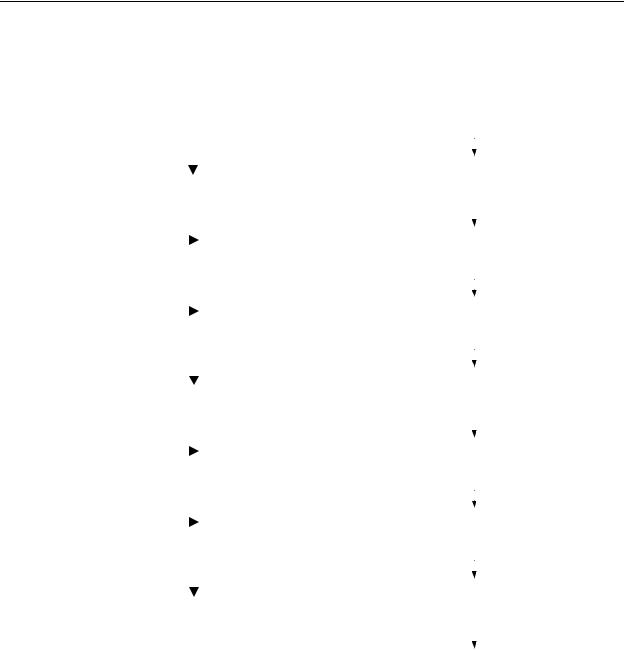
1.4Enabling Ports
Set all ports you want to use to [Enable] on the control panel. Use the following procedure to enable each port.
The following procedure uses IPP as an example.
1. |
Press the <Menu> button on the control |
|
|
|
Menu |
||||
|
panel to display the menu screen. |
|||
|
Print Language |
|||
|
|
|||
2. |
Press the < > button until [Admin Menu] is |
|
|
|
|
|
|||
|
|
|||
|
|
|||
Menu |
||||
|
displayed. |
|||
|
Admin Menu |
|||
|
|
|||
3. |
Press the < > button to accept the |
|
|
|
|
|
|||
|
|
|||
|
|
|||
Admin Menu |
||||
|
selection. |
|||
|
Network / Port |
|||
|
[Network/Port] is displayed. |
|||
|
|
|
||
|
|
|
||
4. |
Press the < > button to accept the |
|
|
|
|
|
|||
Network / Port |
||||
|
selection. |
|||
|
Parallel |
|||
|
[Parallel] is displayed. |
|||
|
|
|
||
|
|
|
||
5. |
Press the < > button until the desired |
|
|
|
|
|
|||
Network / Port |
||||
|
protocol is displayed. (Example: IPP). |
|||
|
IPP |
|||
|
|
|||
6. |
Press the < > button to select the |
|
|
|
|
|
|||
|
|
|||
|
|
|||
IPP |
||||
|
protocol. |
|||
|
Port Status |
|||
|
[Port Status] is displayed. |
|||
|
|
|
||
|
|
|
||
7. |
Press the < > button to accept the |
|
|
|
|
|
|||
Port Status |
||||
|
selection. |
|||
|
Disable* |
|||
|
The current setting is displayed. |
|||
|
|
|
||
|
|
|
||
8. |
Press the < > button to display [Enable]. |
|
|
|
|
|
|||
Port Status |
||||
|
|
|||
|
|
|
Enable |
|
9. |
Press the <Eject/Set> button to confirm the |
|
|
|
|
|
|||
|
|
|||
|
|
|||
Port Status |
||||
|
selection. |
|||
|
|
Enable* |
||
|
The display shows [Reboot to apply |
|
||
|
|
|
||
|
|
|
||
|
settings] for 3 seconds and returns to the |
|
|
|
|
setting screen. |
|
|
|
10.The setting is now complete.
Reboot the printer by switching the power off and then on again.
28 1 Printer Environment Settings
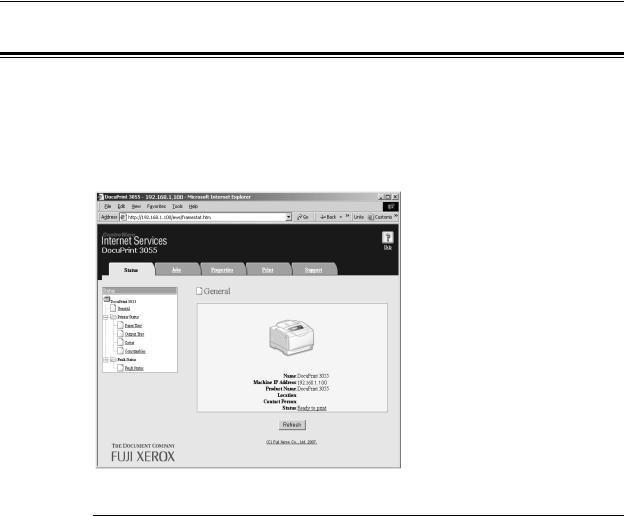
1.5Configuring the Printer Using CentreWare Internet Services
Overview of CentreWare Internet Services
CentreWare Internet Services is a service that allows you to monitor or remotely configure the printer using a web browser when the printer is on a TCP/IP network.
Some of the control panel settings can be set also on the service's [Properties] tab.
Note
• CentreWare Internet Services cannot be used when your printer is a local printer.
Supported Operating Environments
Supported Web Browsers
CentreWare Internet Services has been tested to work on the following web browsers.
On Windows 2000, Windows XP, or Windows Server 2003
•Microsoft Internet Explorer 6.0
•Mozilla Firefox 1.5
On Mac OS X 10.4
•Mozilla Firefox 1.5
•Safari 2.x
1.5 Configuring the Printer Using CentreWare Internet Services |
29 |
Setting Up a Web Browser
When accessing CentreWare Internet Services, we recommend you to set your web browser:
•not to use a proxy server when specifying the printer’s IP address.
•to enable JavaScript.
Note
•If you access CentreWare Internet Services using a proxy server, the response from the service may be slow or the window of the service may not display.
•Some buttons on the service do not appear when JavaScript is not running or disabled. In such case, the buttons are displayed as URL links.
•For information on how to set up your web browser, refer to the online help for the web browser.
If you want to change the display language of CentreWare Internet Services, change the display language of your web browser.
Note
•For information on how to change the display language of your web browser, refer to the online help for the web browser.
Setting Up the Printer
To use CentreWare Internet Services, you must configure the printer's IP address and enable [InternetServices] (default: [Enable]). When [InternetServices] is set to [Disable], change it to [Enable] on the control panel.
Refer to
•"[Internet Services]" (P. 112)
•"1.4 Enabling Ports" (P. 28)
30 1 Printer Environment Settings
